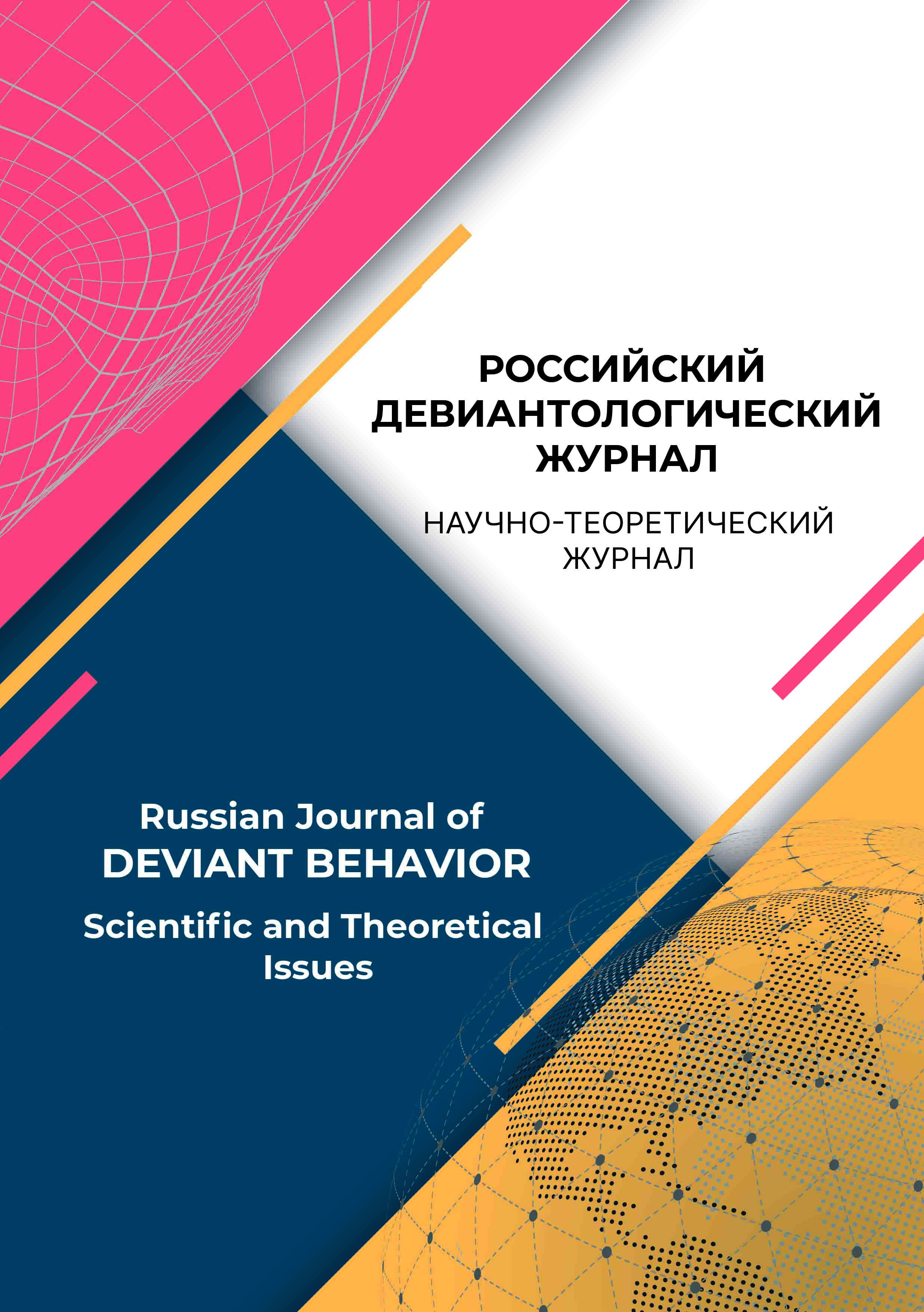Moscow, Moscow, Russian Federation
Moskva, Moscow, Russian Federation
Introduction. The topicality of the research is caused by both traditions of the scientific research of pedagogical social perception and extremely high degree of attention on the side of political, professional and expert community to the problem of education. The pedagogical study of aggression plays an important role in understanding of the strategy for developing programs of improving professional competence of pedagogues and specialists in the sphere of prevention of juvenile delinquent behavior. Aim. Some research problems were examined in order to find the answers to the following problems: the facts that prove aggressive juvenile delinquent behavior, the reasons of juvenile behavior, the reaction of pedagogues on conflict situations and their emotions when they confront situations of aggressive behavior. Methodology and methods. In the process of research different methods were used such as psychological tests, different types of questionnaires and others. More than 13000 of pedagogues from six federal districts participated in the project “Pedagogue as a subject of upbringing of the youth and prevention of delinquent behavior”. The results. Data are given about the fact that pedagogues consider depressed state and aggressive behavior of the child to be the testimony of aggressive behavior of adults towards the child. Boys are more inclined to be aggressive, while the girls try not to show obviously their aggressive behavior. Children from troubled and incomplete families are more aggressive. Attention is drawn to the fact that the main risks of aggressive behavior of juveniles are in the families where the parents are indifferent to the child, do not pay attention to him or her or their requirements are contradictory. The research showed that pedagogues feel trouble, anxiety and fear when they come across conflict situations between the pupils. Practical significance. The results of the research are very important both in the context of improving the programs for pedagogues and psychologists in the sphere of juvenile deviant and antisocial behavior prevention and in the context of educational and youth policy and its tasks.
teacher, adolescent aggressiveness, social perception, intervention
1. Baldry, A. C. (2003). Bullying in schools and exposure to domestic violence. Child abuse & neglect, 27(7), 713-732. https://DOI.org/10.1016/s0145-2134(03)00114-5
2. Baraldsnes, D. (2020). Bullying prevention and school climate: Correlation between teacher bullying prevention efforts and their perceived school climate. International Journal of Developmental Science, (Preprint), 1-11. Okonchatel'naya publikaciya dostupna v IOS Press po adresu https://DOI.org/10.3233/dev-200286.
3. Coplan, R. J., Bullock, A., Archbell, K. A., & Bosacki, S. (2015). Preschool teachers’ attitudes, beliefs, and emotional re-actions to young children’s peer group behaviors. Early childhood research quarterly, 30, 117-127. https://DOI. org/10.1016/j.ecresq.2014.09.005
4. Craig, W. M., Henderson, K., & Murphy, J. G. (2000). Prospective teachers’ attitudes toward bullying and victimization. School Psychology International, 21(1), 5-21. https://DOI.org/10.1177/0143034300211001
5. Downs, W. R., & Harrison, L. (1998). Childhood maltreatment and the risk of substance problems in later life. Health & social care in the community, 6(1), 35-46. https://DOI.org/10.1046/j.1365-2524.1998.00097.x
6. Espelage, D. L., Bosworth, K., & Simon, T. R. (2000). Examining the social context of bullying behaviors in early adoles-cence. Journal of counseling & development, 78(3), 326-333. DOI: 10.1002 / j.1556-6676.2000.tb01914.x
7. Fiske, S. T., & Taylor, S. E. (1991). Social cognition. Mcgraw-Hill Book Company.
8. Gilbert, R., Widom, C. S., Browne, K., Fergusson, D., Webb, E., & Janson, S. (2009). Burden and consequences of child maltreatment in high-income countries. The lancet, 373(9657), 68-81. https://DOI.org/10.1016/s0140-6736(08)61706-7
9. Hazler, R. J., Miller, D. L., Carney, J. V., & Green, S. (2001). Adult recognition of school bullying situations. Educational Research, 43(2), 133-146. https://DOI.org/10.1080/00131880110051137
10. Larkin, R. W. (2013). Legitimated adolescent violence: Lessons from Columbine. School Shootings (pp. 159-176). NY: Springer. DOIhttps://doi.org/10.1007/978-1-4614-5526-4_7
11. Nesdale, D., & Pickering, K. (2006). Teachers’ reactions to children’s aggression. Social Development, 15(1), 109-127. https://DOI.org/10.1111/j.1467-9507.2006.00332.x
12. Salimi, N., Karimi-Shahanjarin, A., Rezapur-Shahkolai, F., Hamzeh, B., Roshanaei, G., & Babamiri, M. (2021). Use of a Mixed-Methods Approach to Evaluate the Implementation of Violence and Bullying Prevention Programs in Schools. Education and Urban Society, 53(6), 607-628. https://DOI.org/10.1177/0013124520972090
13. Turner, J. C., Brown, R. J., & Tajfel, H. (1979). Social comparison and group interest in ingroup favouritism. European journal of social psychology, 9(2), 187-204. https://DOI.org/10.1002/ejsp.2420090207
14. van Verseveld, M. D., Fekkes, M., Fukkink, R. G., & Oostdam, R. J. (2021). Teachers’ experiences with difficult bully¬ing situations in the school: An explorative study. The Journal of Early Adolescence, 41(1), 43-69. https://DOI. org/10.1177/0272431620939193
15. Varela, J. J., Sirlopú, D., Melipillán, R., Espelage, D., Green, J., & Guzmán, J. (2019). Exploring the influence school climate on the relationship between school violence and adolescent subjective well-being. Child Indicators Research, 12(6), 2095-2110. https://DOI.org/10.1007/s12187-019-09631-9
16. Voisin, D. R., & Hong, J. S. (2012). A meditational model linking witnessing intimate partner violence and bullying behav-iors and victimization among youth. Educational Psychology Review, 24(4), 479-498.
17. Bochaver, A. A., Zhilinskaja, A. V., & Hlomov, K. D. (2015). Shkol’naja travlja i pozicija uchitelej. Social’naja psihologija i obshhestvo, 6(1), 103-116.
18. Volkova, E. N., Volkova, I. V., & Skitnevskaja, L. V. (2017). Kul’turno-istoricheskaja teorija L.S. Vygotskogo kak metod-ologicheskoe osnovanie dlja issledovanij podrostkovogo bullinga. Teoreticheskaja i jeksperimental’naja psihologi¬ja, 10(2). 6-17.
19. Volkova, E. N., Cvetkova, L. A., & Volkova, I. V. (2019). Metodologicheskie osnovanija dlja razrabotki programm profilak-tiki podrostkovogo bullinga. Sibirskij psihologicheskij zhurnal, 74, 88-99. DOI:https://doi.org/10.17223/17267080/74/5
20. Rean, A. A. (2018). Profilaktika agressii i asocial’nosti nesovershennoletnih. Nacional’nyj psihologicheskij zhurnal, 2 (30), 3-12. DOI:https://doi.org/10.11621/npj.2018.0201
21. Rean, A. A. (2015). Sem’ja kak faktor profilaktiki i riska viktimnogo povedenija. Nacional’nyj psihologicheskij zhurnal, 1(17), 3-8.
22. Rean, A. A., & Kolominskij, Ja. L. (2000). Social’naja pedagogicheskaja psihologija. Saint Petersburg: Piter.
23. Rean, A. A., & Konovalov, I. A. (2019). Projavlenie agressivnosti podrostkov v zavisimosti ot pola i social’no-jekonomich-eskogo statusa sem’i. Nacional’nyj psihologicheskij zhurnal, 1 (33), 23-33. DOI:https://doi.org/10.11621/npj.2019.0103
24. Rean, A. A., & Novikova, M. A. (2019). Bulling v srede starsheklassnikov Rossijskoj Federacii: rasprostranennost’ i vlijanie sociojekonomicheskih faktorov. Mir psihologii, 1(97), 165-177.
25. Fomichenko, A. S. (2013). Predstavlenija uchitelej o prichinah agressivnogo povedenija uchashhihsja raznyh klassov obshheobrazovatel’noj shkoly. Social’naja psihologija i obshhestvo, 4(2), 81-93.
26. Fomichenko, A. S. (2019). Osobennosti vlijanija haraktera vzaimodejstvija v sisteme» uchitel’-uchenik» na processy obuchenija i razvitija shkol’nikov (po materialam zarubezhnyh publikacij). Sovremennaja zarubezhnaja psihologija, 8(1), 76-83. https://DOI.org/10.17759/jmfp.2019080108.

















